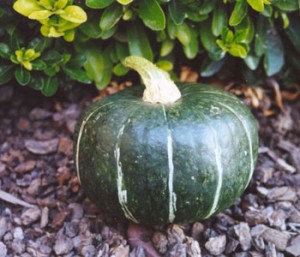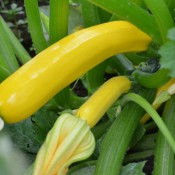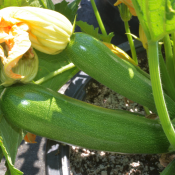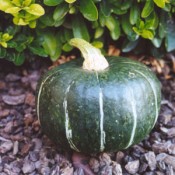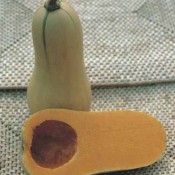Cucurbita pepo.
Squash was one of the oldest and most important food crops. People from Central America and Mexico not only ate squash, but they used the gourds to make water jugs, bowls, and ceremonial masks, and they wove the stringy fibers of some varieties into cloth. Squash come in many colours, shapes, sizes, and textures. The most common classification system is according to the summer and winter seasons, which isn’t really valid in temperate climate regions like California, where many types grow virtually year-round.
Summer squash: Summer squash have soft edible shells and small edible seeds. They are picked when still immature and tender-skinned. Summer squash varies widely in shape and skin colour – but all types have a mild, delicate flavour. Some of the most popular kinds of summer squash include the zucchini (Italian squash or courgette) – typically straight, slim, and dark green; the yellow crookneck, a pale yellow, sometimes bumpy-skinned squash with a curved neck; and pattypan, or scallop, which is disc-shaped and pale green with scalloped edges.
Winter squash: Winter squash have hard inedible shells and big seeds, some of which can be roasted and eaten. They are allowed to reach maturity before being harvested and will keep longer than summer squashes. These bountiful and delicious squashes are available in a truly amazing variety of shapes, forms, and colours. The most popular winter squash include the pumpkin; acorn squash which is blackish green with shades of yellow and a shape like a large acorn; butternut, which has cream-coloured skin, deep orange meat, and a large cylindrical shape; and kabocha, which is blackish with shades of orange and yellow. Spaghetti squash falls somewhere between summer and winter squash in skin hardness and when cooked, the flesh forms strands that resemble spaghetti.
Good companion plants for squash include corn, lettuce, melons, oregano, peas, radish, and squash. Some experts believe that borage improves the pollination, flavour, and growth of squash. Planting flowers such as marigolds and nasturtiums, help repel pesky squash insects. Avoid planting squash with Brassicas (cabbage, broccoli, kale, etc.) and potatoes.
| Nutrition | Summer squash are high in vitamin C and extremely low in calories-a cup of cooked squash is only about 25 calories.Winter squash are low in sodium and an excellent source of vitamin A. The calorie count of cooked winter squash ranges from 90 to 130 per cup. All squash are high fiber. |
|---|---|
| Harvesting | Summer squash: When the fruit appear, check summer squash (especially zucchini) daily because the quality declines if the fruit become oversized. Most summer squash plants have hairy or spiny stems and leaves. To avoid skin irritation, wear long sleeves and gloves when harvesting. Use scissors, pruners or knife to cut squash from the plants leaving about 1 inch (2.5cm) of stem attached.Winter squash: When winter squash and pumpkins are ripe, the rind turns slightly dull. The rind should be tough enough to withstand light pressure. Cut the fruit off the vines, leaving 2 inches (5cm) of stem attached to the fruit. Handle them carefully. |
| Storing | Summer squash: Store the squashes unwashed in plastic bags for up to four to five days in the refrigeratorWinter squash: Cure squash at 85-90°F (29-32°C) for several days to promote hardening of the rind; then move the fruit to a cool area for storage. Ideally, the storage area should have temperatures of 50-60°F (10-15°C) and humidity of 50 to 75 percent. Under the right conditions, the squash can be stored for 2 months or longer. |
Varieties Listing
This attractive bright yellow-fruited variety has a strong plant frame and tidy habit. It has attractive foliage and produces lots of bright yellow fruit throughout the season. It is ideal for pot and container production or open ground. The large yellow flowers are ideal for use as edible flowers or for stuffing.
Noche zucchini is a dark green variety that has delivered excellent fruit quality and very good yield potential. It is virus tolerant and produces 7-8” (18 – 20 cm) smooth glossy cylindrical fruit. DID YOU KNOW… Zucchini is a good source of vitamins C and A, magnesium, fiber, manganese, potassium, copper and folate. Good tasting… Read more »
Sweet, rich flavour makes this squash a perennial favourite. The vines produce flattened turban-shaped squash that are 5 – 8” (13 – 20 cm) in diameter and about 4 lbs (1.8 Kg) in weight. The rind of this 1932 heritage squash is deep green with a bit of ribbing and button on the blossom end…. Read more »
This AAS winner is by far a garden favourite. It produces heavy yields of 12″ (31 cm), light-tan fruit that keep exceptionally well. Each 3 – 6 lbs ((1.3 – 2.7 Kg) blocky pear-shaped squash has rich, creamy yellow-orange flesh with a delightful, nutty flavour. Not only famous for taste, this heirloom variety also has… Read more »
Back to Organic Edibles.

